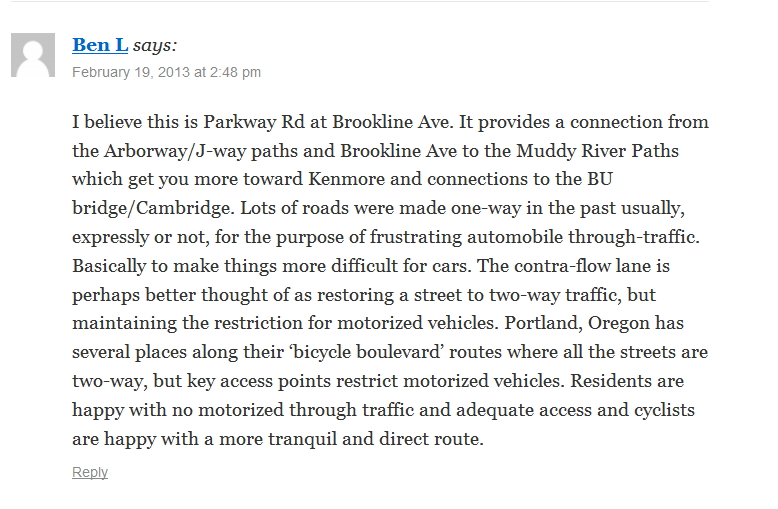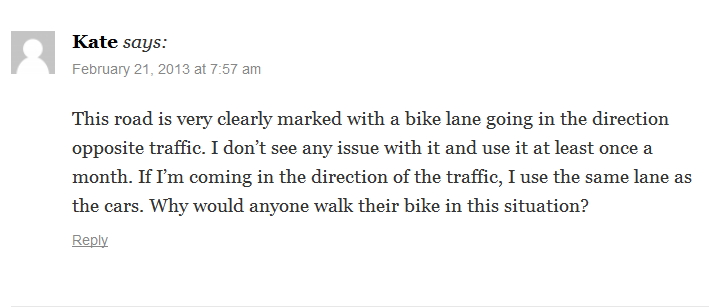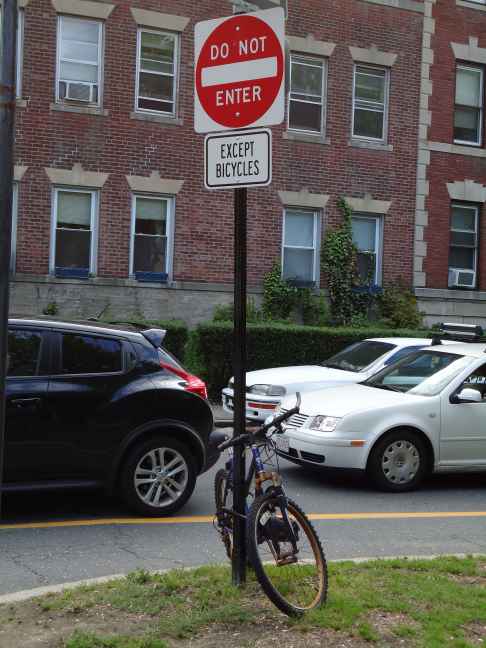A couple of weeks ago I wrote a post about an ambiguous sign which was placed at the entrance of a one-way street. The sign below a “do not enter” sign only said “except bicycles.” No explanation was given.
Just by looking at the photograph I took of this sign as if I were an out-of-towner or non-cyclist, I could see nothing indicating why the sign was there. All I saw was a row of apartment buildings with a grassy area across the street.
Quite a few people throughout the U.S. and around the world read the post. But only a few readers, all of whom were local cyclists, seemed to know what the sign was for.
The first commenter recognized the arrangement as a contra-flow lane for bikes. Should we take bets on the number of drivers who know what a contra-flow bike lane is? I’ve been riding a bike for years and when I passed this street, which didn’t look as if it led to anything of importance, I didn’t consider it as playing a role for anyone other than the residents of that area.

Now, let’s say I was visiting that area from another state or country (which is a realistic scenario given its proximity to the Longwood Medical Area) and I rented a bike for the day. Would I have any way of knowing that this road could be used as a path to connect the Jamaicaway and the Arborway? Unlikely.
I studied the photo some more in light of a second comment left on the post.

This reader identified the street as Parkway Road. And he provided insight into the use of contra-flow lanes along with information about their presence in Brookline and Cambridge, Massachusetts, as well as in Portland, Oregon. In addition, he relayed a theory about how these lanes came about.
Apparently, these streets were made one-way to reduce motorized traffic for the benefit of the residents. Contra-flow bike lanes were invented, he says, to restore two-way traffic for bicycles, while keeping motorized traffic to a minimum.
Good explanation. It makes perfect sense. However, how is anyone who is unfamiliar with the concept of only restoring two-way traffic to one vehicle type, namely bicycles, supposed to know what they’re looking at when they see a contra-flow bike lane — particularly one that is unmarked?
Another reader who recognized the road in the photograph thought the entire thing was self-evident. Having used the road herself, she couldn’t imagine why anyone wouldn’t know what it was for. She referred to the bike lane as “clearly marked,” but I didn’t see any sign or symbol showing that the yellow stripe down the wrong side of a one-way street was a “bike lane.” The yellow line could have been painted for another purpose.


To add to the confusion, most bike lanes in the Boston area have white paint, not yellow. Without signage, it would be pretty difficult to identify that yellow lined area as a bike lane.
Here is a photograph of what this street looked like a few years ago (courtesy of Google Maps).

According to Google, the photograph was taken in 2009, before the contra-flow lane was installed. That is how the road looked for many years. I wonder how many non-cyclists (and cyclists) who travel along Brookline Avenue are aware of this change.
In addition to providing good information about this road and the meaning of the sign, the commenters proved my point. Only people who are familiar with the area, and how it is used by cyclists, would know what the “except bicycles” sign means.
If Brookline intends to install contra-flow lanes, perhaps they should invest in a bit more signage. A sign marking the start of the bike lane would help. And another sign with information about where the bike lane leads would be beneficial as well. With a bit more communication, the meaning of the sign would no longer be a secret known only by a select few, but would be clear to everyone who drives, rides or walks past that road.
On an unrelated note, it’s worth posting enigmas of this sort on my blog since savvy readers always seem to come along with valuable information. Now if we could only get the individuals responsible for designing and installing signage to put this information to good use, we’d be good to go.



2 Responses to People Who Know The Hidden Meaning Of Traffic Signs